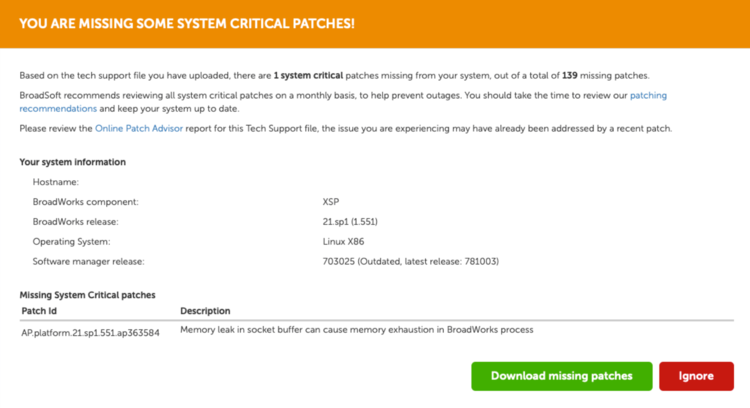Still Trending
According to data from Google Trends, interest in the search term "BroadSoft" and "BroadWorks" has actually grown in the last two years when compared to the two years before Cisco's acquisition of BroadSoft. This suggests that, despite the reduction of direct marketing for those brand names, general awareness of the platform is still around.
Cisco is investing in improvements in the Execution Server ("XS"), primarily used by mobile operators in IMS deployments, Cisco is adding PBX and Unified Communications features that were previously only available in Application server mode. These features such as Call Logs, Push to Talk, and Group Paging were previously not available for many IMS mobile operators using the XS Mode. Cisco has made efficiency enhancements in the long-standing SIP feature for Busy Lamp Field, reducing the number of SIP signaling messages in the popular feature. (The XS Mode is no longer offered for sale, but IMS can be provided in AS Mode.)
System Management
All BroadWorks servers except the Application Server (AS) are moving to Release Independent versions. This means the servers will no longer be patched, but instead upgraded periodically. For most servers, this removes the longstanding capability of customers to pick-and-choose individual patches to apply, relying instead on simply activating the desired functions.
The new Application Delivery Platform (ADP), replaces the Profile Server and the xTended Services platform (XSP). Applications will be deployed to the ADP in largely the same way they were deployed on previous servers. Tools are provided to convert existing servers to the ADP.
The Network Function Manager, NFM, offers as a replacement for the Element Management System (EMS), It now includes a pre-configured collection of Key Performance Indicators (KPIs) for monitoring BroadWorks. Up until now, seeing easily whether a BroadWorks platform is functioning “at a glance” well has required extensive development work and/or 3rd party solutions
Cisco moves further adopting the use of Ansible, a product from IBM's division Red Hat, for server automation. Ansible promises to change the way BroadWorks software is installed and maintained on servers, ideally reducing the painstaking process of copying files and cross-configuring servers on a command line.
Cisco made progress moving to a standard Cisco documentation format, announcing today that field notices would be published on Cisco.com. Cisco continues to send email alerts to notify customers about changes required to maintain their platform.
Call Center
Call Center continues to evolve, but BroadWorks is dropping new sales for the ability to generate reports directly. Instead, a new feature, Call Center Event Reporting (CCER) has been added to record events to JSON formatted text files. (Existing customers using ECCR can continue to do so, but new DBS servers cannot be licensed.)
An enhancement for Call Center called Supervisor Coaching allows a supervisor to join a call center call with an agent and a caller, but speak only to the agent.
Cisco is releasing several new features around the programmable Route Point API, including some for on call center agents. These can enhance operators' abilities to develop complex call flows for calls routed through BroadWorks.
Device Management
Device Management of Cisco devices will get easier with the new Device Activation functionality, added to simplify the assignment of SIP endpoint devices to users in BroadWorks. Other device vendors will continue to rely on other platforms for device activation.
Despite new TLS capabilities in its servers, Cisco continues to recommend the use of a Web Application Firewall, often called a load balancer, between SIP access devices and the Device Management web server, the XSP. This device is intended to mitigate DDoS attacks, perform certain TLS functions, and prevent other attacks against the XSP.
The speed of generating device configuration files will get a boost in R24 as the number of CPU threads available to generate configuration files can be managed.
Device Management custom tags are enhanced with the support of "device families" to share tag sets between related device types. Another new capability allows tags to be automatically overridden based on the region or country of the device.
Since Cisco's purchase, the addition of new partner guides has plummeted, from 62 new device types just prior to the acquisition in 2017 to only 8 new device types in 2019. Device and Software makers may be taking a wait-and-see approach to Cisco's management of BroadWorks.
Cisco Integration
Many carriers are going to market with Webex for BroadWorks while some are still maintaining classic UC-One Collaborate and UC-One SaaS, also known as UC-Connect. Webex for BroadWorks removes the option of a branded mobile app for each operator. At a recent event, some at Cisco call the Webex app "your new desk phone", but also announced a new desktop device, "Webex Desk Hub".
New integration enhancements allow other Cisco calling platforms, Unified Communication Manager (UCS) and Hosted Collaboration Solution, HCS, to add cellular-network integrations through BroadWorks. This suggests a clear bifurcation between the carrier-focused BroadWorks and Enterprise-focused UCM and HCS.
Compliance
Enhancements were added to support compatibility with new E911 emergency calling regulations in the US, including Kari's Law and RAY BAUM'S Act. BroadWorks can now send a notification via email when an emergency call is placed. BroadWorks already had the necessary to send a distinct calling party ID for each user, a feature potentially required by the new dispatchable location requirements.
BroadWorks can now directly contact SHAKEN/STIR servers for secure identity attestation and verification. This will help operators comply with the FCC rules published in September requiring caller authentication tagging even for calls within their network
The enhanced encryption standard TLSv1.3 appeared in the command-line on the Application Delivery Platform (ADP) indicating that support for the new standard is on the way. With the eventual migration to TLS 1.3, some conventional approaches to troubleshooting will no longer be available.
Several changes have been made to allow operators to anonymize or encrypt personally-identifiable information (PII). This includes the obfuscation of passcodes, which have long been visible in logs. This will help operators comply with California consumer privacy laws, European Union's "General Data Protection Regulation" (GDPR), and the United States' federal healthcare data law, HIPAA. Cisco does not certify compliance with any particular standard however, leaving it to external assessors like ECG to confirm the particular encryption standards against the regulations.
Support for Encryption In Transit gets a boost as HTTPS support is added for transfer of media files between BroadWorks servers. Many other file transfers are already encrypted.
To support robocalling prevention, BroadWorks has inbound call blocking support allowing numbers to be provisioned, allowing an operator to provision up to 10 million telephone numbers from which calls will be blocked.
No-Show at the Show
Cisco held the Webex One conference as a virtual event in early December, which they promised to be a replacement for BroadSoft Connections. While they did have a few BroadWorks-focused sponsors supporting the event, the primary presence of BroadWorks was behind the scenes as the calling platform for Webex Calling. No sessions were held focused on BroadWorks, and Cisco staff performing one-on-one demos were focused on Webex and Unified Communications Manager features.


